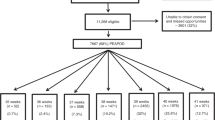Abstract
This study was performed to prove the applicability of the small-for-gestational age (SGA), appropriate-for-gestational age (AGA), and large-for-gestational age (LGA) classification depending on birth weight to predict percentage body fat (%BF) measured by dual-energy X-ray absorptiometry (DXA) in term and preterm infants. The data of 159 healthy term and preterm neonates (87 boys and 72 girls) with a gestational age at delivery of 38.4 weeks from two longitudinal studies were analyzed. Anthropometry and body composition data were assessed within the first 10 days after birth. Correlations between anthropometric parameters and fat mass measured by DXA were calculated. Prevalences of observations with low, middle, and high %BF measured by DXA were compared between SGA, AGA, and LGA groups, according to sex and gestational age. In term infants, 42.9% of the newborns with less than 10% body fat were classified to be AGA; 9.9% of all AGA newborns had less than 10% body fat. For the whole group, among the ratios investigated, the weight–length ratio (r=0.82) showed the best correlation to fat mass measured by DXA. The %BF at the time of study was higher in girls (14.75%) than in boys (11.95%). In conclusion, traditional classification based on birth weight centiles does not reflect %BF in term and preterm newborns.


Similar content being viewed by others
Abbreviations
- AGA:
-
Appropriate-for-gestational age
- BMC:
-
Bone mineral content
- BMI:
-
Body mass index
- BW%:
-
Birth weight percentile
- DXA:
-
Dual-energy X-ray absorptiometry
- FM:
-
Fat mass
- LBM:
-
Lean body mass
- LGA:
-
Large-for-gestational age
- PI:
-
Ponderal index
- SGA:
-
Small-for-gestational age
- W/L:
-
Weight–length ratio
- %BF:
-
Percentage body fat
References
Braillon PM, Salle BL, Brunet J, Glorieux FH, Delmas PD, Meunier PJ (1992) Dual energy x-ray absorptiometry measurement of bone mineral content in newborns: validation of the technique. Pediatr Res 32(1):77–80
Butte NF, Hopkinson JM, Wong WW, Smith EO, Ellis KJ (2000) Body composition during the first 2 years of life: an updated reference. Pediatr Res 47(5):578–585
Davies PSW, Lucas A (1989) Quetelet’s index as a measure of body fatness in young infants. Early Hum Dev 20:135–141
Davies PS, Lucas A (1990) The prediction of total body fatness in early infancy. Early Hum Dev 21(3):193–198
de Bruin N, van Velthoven KAM, Stijnen T, Juttmann RE, Degenhart HJ, Visser HKA (1995) Body fat and fat-free mass in infants: new and classic anthropometric indexes and prediction equations compared with total-body electrical conductivity. Am J Clin Nutr 61(6):1195–1205
Fusch C, Slotboom J, Fuehrer U, Schumacher R, Keisker A, Zimmermann W, Moessinger A, Boesch C, Blum J (1999) Neonatal body composition: dual-energy X-ray absorptiometry, magnetic resonance imaging, and three-dimensional chemical shift imaging versus chemical analysis in piglets. Pediatr Res 46(4):465–473
Hammami M, Walters JC, Hockman EM, Koo WW (2001) Disproportionate alterations in body composition of large for gestational age neonates. J Pediatr 138(6):817–821
Hediger ML, Overpeck MD, Kuczmarski RJ, McGlynn A, Maurer KR, Davis WW (1998) Muscularity and fatness of infants and young children born small- or large-for-gestational-age. Pediatrics 102(5):E60
Koo WWK, Massom LR, Walters J (1995) Validation of accuracy and precision of dual energy X-ray absorptiometry for infants. J Bone Miner Res 10(7):1111–1115
Koo WW, Walters JC, Hockman EM (2004) Body composition in neonates: relationship between measured and derived anthropometry with dual-energy X-ray absorptiometry measurements. Pediatr Res 56(5):694–700
Lapillonne A, Braillon P, Claris O, Chatelain PG, Delmas PD, Salle BL (1997) Body composition in appropriate and in small for gestational age infants. Acta Paediatr 86(2):196–200
Lapillonne A, Braillon PM, Delmas PD, Salle BL (1997) Dual-energy X-ray absorptiometry in early life. Horm Res 48(Suppl 1):43–49
Lapillonne A, Salle BL, Glorieux FH, Claris O (2004) Bone mineralization and growth are enhanced in preterm infants fed an isocaloric, nutrient-enriched preterm formula through term. Am J Clin Nutr 80(6):1595–1603
Picaud JC, Rigo J, Nyamugabo K, Milet J, Senterre J (1996) Evaluation of dual-energy X-ray absorptiometry for body composition assessment in piglets and term human neonates. Am J Clin Nutr 63(2):157–163
Rigo J, De Curtis M, Pieltain C, Picaud JC, Salle BL, Santerre J (2000) Bone mineral metabolism of the micropremie. Clin. Perinatol 27(1):147–70
Rohrer F (1921) Der Index der Körperfülle als Maß des Ernährungszustandes. Münch Med Wochenschr 68:580–582
Schmelzle HR, Fusch C (2002) Body fat in neonates and young infants: validation of skinfold thickness versus dual-energy X-ray absorptiometry. Am J Clin Nutr 76(5):1096–1100
Thomas P, Peabody J, Turnier V, Clark RH (2000) A new look at intrauterine growth and the impact of race, altitude, and gender. Pediatrics 106(2):E21
vd Wagen A, Okken A, Zweens J, Zijlstra WG (1985) Composition of postnatal weight loss and subsequent weight gain in small for dates newborn infants. Acta Paediatr Scand 74(1):57–61
Weller U, Jorch G (1993) Aktuelle Perzentilenkurven für Körpergewicht, Körperlänge und Kopfumfang von Neugeborenen ab 25. SSW. Monatsschr Kinderheilkd 141:665–669
Williams RL, Creasy RK, Cunningham GC, Hawes WE, Norris FD, Tashiro M (1982) Fetal growth and perinatal viability in California. Obstet Gynecol 59(5):624–632
Acknowledgments
We would like to thank all of the children and parents who took part in this study. Special thanks go to M. Hoyer for technical assistance in anthropometric measurements, to M. Fusch and I. Kadow for their restless engagement in recruiting babies for the study, as well as to M. Heukäufer for statistical help. The study was supported in part by Novartis Nutrition, Berne, Switzerland. The DXA device was provided by the support of the Swiss National Research Foundation (grant no. 3200-43586).
Author information
Authors and Affiliations
Corresponding author
Rights and permissions
About this article
Cite this article
Schmelzle, H.R., Quang, D.N., Fusch, G. et al. Birth weight categorization according to gestational age does not reflect percentage body fat in term and preterm newborns. Eur J Pediatr 166, 161–167 (2007). https://doi.org/10.1007/s00431-006-0209-x
Received:
Revised:
Accepted:
Published:
Issue Date:
DOI: https://doi.org/10.1007/s00431-006-0209-x




